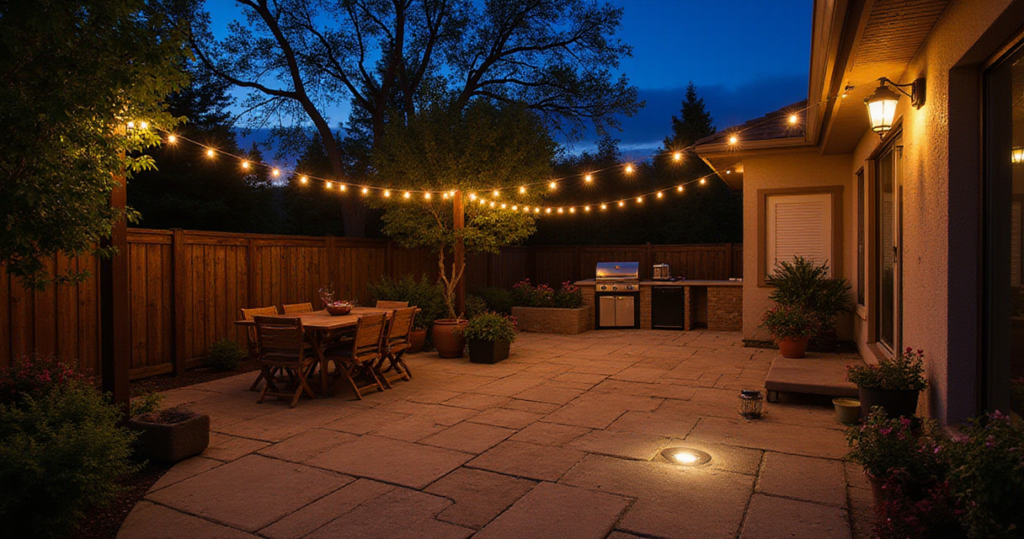Picture stepping onto your patio as twilight descends, and instead of retreating indoors to harsh overhead lighting, you’re welcomed by a warm constellation of carefully placed illumination. The right patio lights don’t just banish darkness—they weave magic into ordinary evenings, transforming your outdoor space into an enchanting extension of your home where memories are made and stories unfold.
As someone who has spent years helping families breathe new life into vintage spaces while honoring their authentic character, I’ve witnessed firsthand how thoughtful lighting can bridge the gap between past and present. Whether you’re working with a mid-century modern ranch or a charming craftsman bungalow, the principles of good outdoor lighting remain timeless: create layers, embrace warmth, and let each fixture tell part of your home’s story.
From solar-powered string lights that dance through heritage oak trees to restored Edison bulbs casting their amber glow over family gatherings, this collection of 21 brilliant patio light ideas will guide you through creating an outdoor sanctuary that honors both function and beauty. Let’s illuminate the path to your perfect evening retreat.
1. Define Your Lighting Purpose: Ambiance, Task, or Security
Before you fall in love with those charming bistro bulbs or sleek modern fixtures, take a moment to truly understand what you need your patio lights to accomplish. This foundational step prevents the all-too-common mistake of creating a beautifully lit space that doesn’t actually serve your lifestyle—like installing romantic string lights over a grilling station where you need bright, focused illumination.
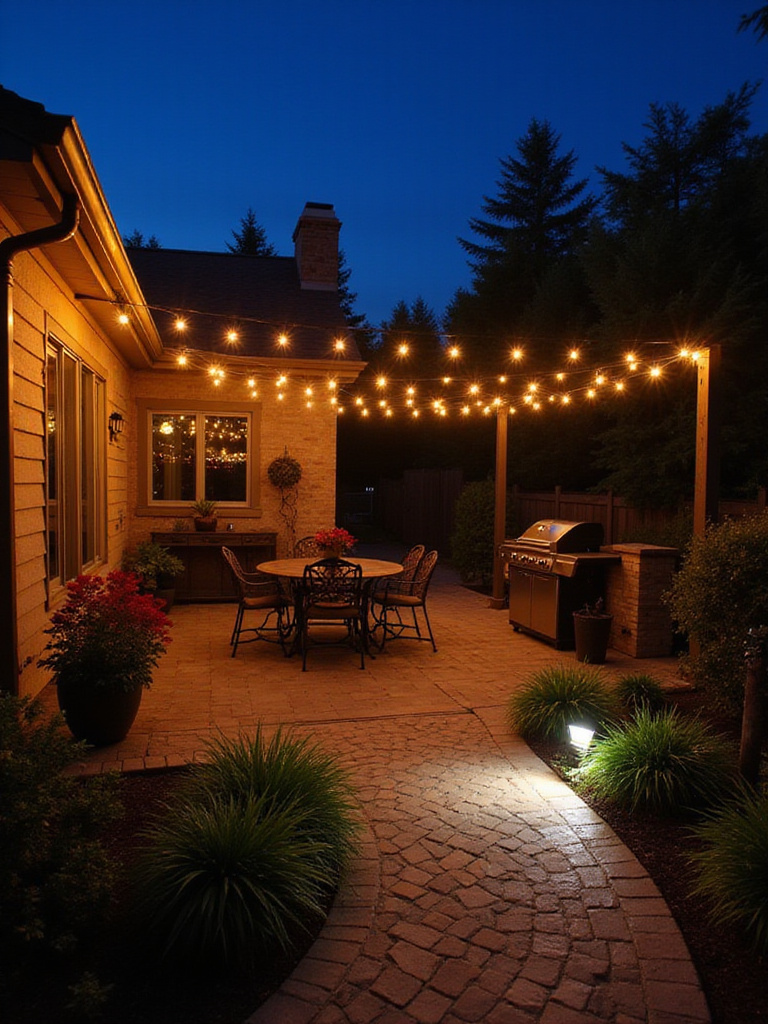
Start by walking your outdoor space during your typical evening routines. Do you need bright task lighting for that vintage outdoor kitchen you’ve been restoring? Soft ambient lighting for intimate conversations around your mid-century fire bowl? Or perhaps security lighting along pathways where family heirlooms and garden treasures need protection? Each purpose requires different fixture types, brightness levels, and placement strategies. A well-planned lighting scheme can reduce energy consumption by up to 30% while increasing your outdoor space’s usability by 40% for evening activities.
- Ambient lighting: Creates overall mood with soft, diffused illumination (string lights, lanterns)
- Task lighting: Provides focused brightness for specific activities (under-cabinet strips, spotlights)
- Security lighting: Illuminates pathways and entry points for safety (motion sensors, pathway lights)
The magic happens when you layer these purposes thoughtfully, creating depth and functionality that evolves with your needs throughout the evening.
2. Measure Your Space for Perfect Light Placement
Nothing disrupts the flow of a beautifully planned outdoor space quite like patio lights that fall short of their intended destination or create awkward gaps in your design. Accurate measurements ensure your lighting installation feels intentional and professionally executed, avoiding the frustration of re-ordering materials or compromising your vision.
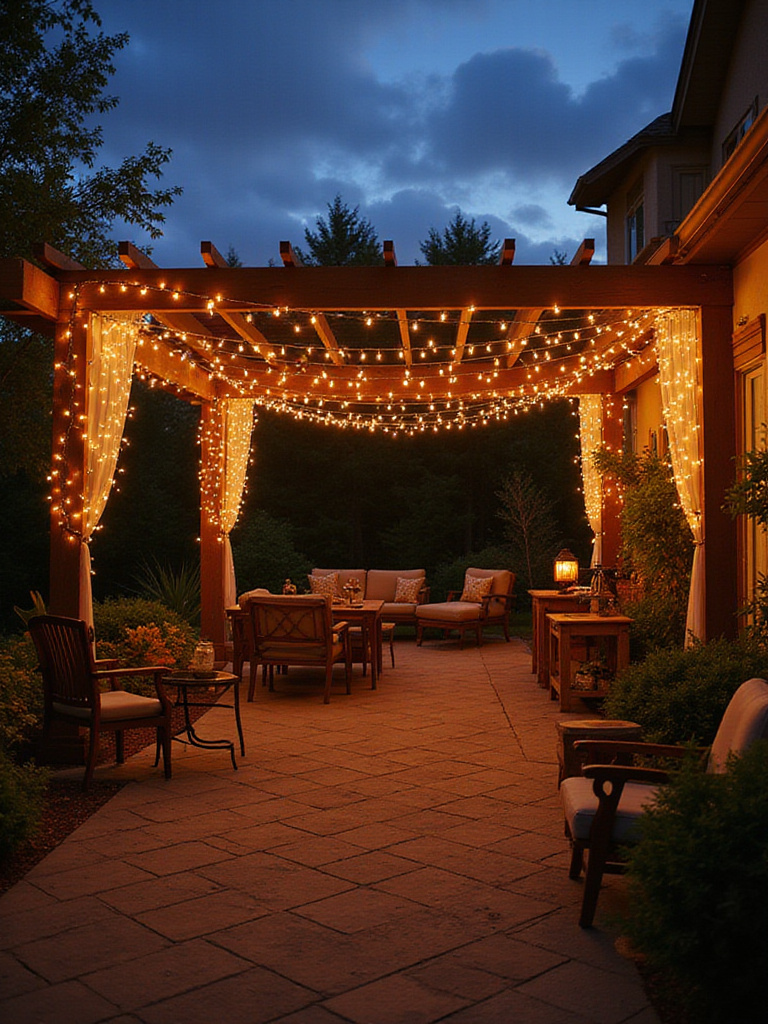
Begin with a simple sketch of your patio layout, noting existing structures like pergolas, mature trees, or architectural features that could serve as anchor points. When measuring for overhead installations, remember to account for the gentle sag that creates visual appeal—typically adding 10-20% extra length gives you that perfect, relaxed drape reminiscent of European bistro courtyards. Don’t forget to measure the distance from your power source to where the lights will begin, including any necessary extensions around obstacles.
Professional installers consistently emphasize that precise planning prevents both waste and disappointment. Consider the homeowner who meticulously measured their 12×16 foot pergola, factoring in the natural drape and pathway to their outlet—their lights arrived, fit perfectly, and created exactly the ambiance they envisioned, all installed in under an hour.
With your measurements in hand, you’re ready to explore the visual impact of different lighting styles that complement your home’s unique character.
3. Choose Light Styles That Honor Your Home’s Character
Your patio lights should feel like a natural extension of your home’s architectural story, not an afterthought hastily added for functionality. Whether you’re working with a sleek mid-century modern aesthetic or a charming craftsman bungalow, the right lighting style creates seamless continuity between indoor and outdoor living spaces.

For mid-century homes, consider clean-lined fixtures with geometric forms—perhaps sleek pendant lights with brass accents or minimalist string lights with uniform spacing. Craftsman-style homes sing with warm Edison bulbs in metal cages or lantern-style fixtures that echo the era’s handcrafted aesthetic. Mediterranean or Spanish revival homes call for wrought iron fixtures and warm, amber-toned bulbs that complement stucco walls and tile roofs. The key is studying your home’s existing design language and letting it guide your choices.
The most successful outdoor lighting installations feel so natural that guests assume they’ve always been there. A well-chosen style can enhance your outdoor aesthetic and potentially increase perceived property value by 5-10% through elevated curb appeal. Remember, your fixtures will be visible during daylight hours too, so choose pieces that contribute to your space’s beauty even when unlit.
The aesthetic foundation set, let’s explore the technology that will power your vision most efficiently.
4. Embrace LED Technology for Long-Term Value
While vintage-style incandescent bulbs offer undeniable charm with their warm, familiar glow, modern LED technology has evolved to provide that same aesthetic appeal with dramatically superior performance. Today’s LED patio lights can achieve over 80% reduction in electricity consumption while lasting up to 25 times longer than traditional bulbs, making them both environmentally conscious and economically smart.
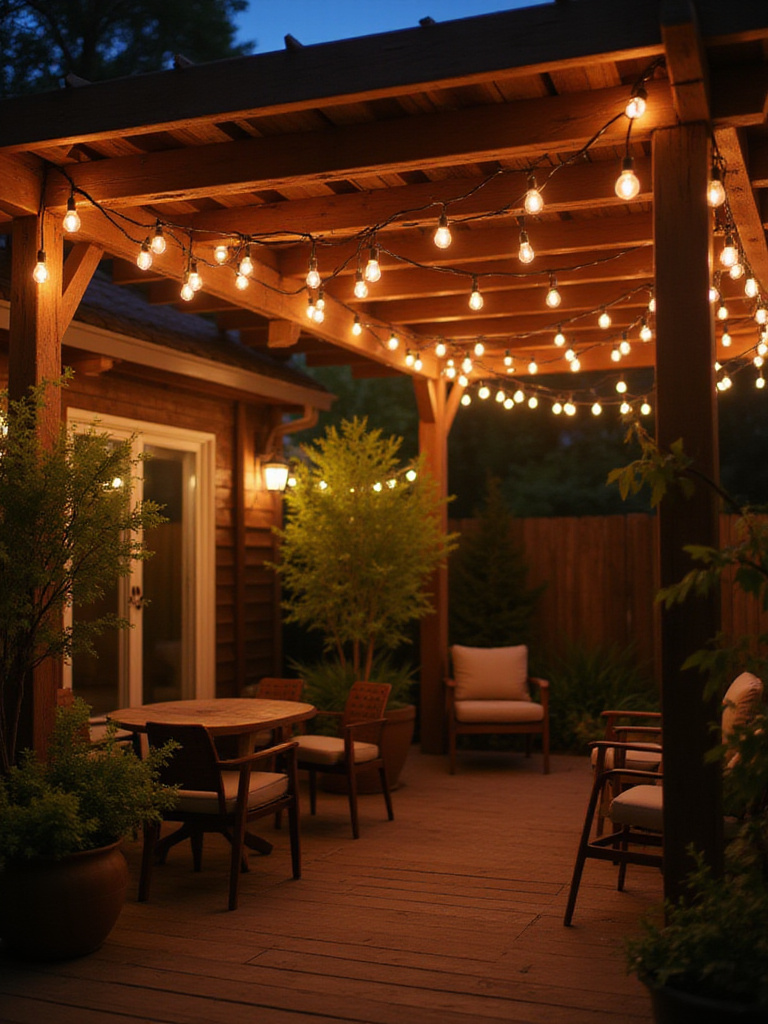
The initial investment in quality LED fixtures pays dividends through reduced replacement frequency and energy costs. Modern LEDs offer sophisticated color temperature options, from the warm 2200K that mimics candlelight to the crisp 3000K perfect for task lighting. Many now feature dimming capabilities and even color-changing options, giving you unprecedented control over your outdoor ambiance. Smart LED systems can integrate with home automation, allowing you to schedule lighting scenes that adapt throughout the evening.
Consider the Johnson family who replaced their traditional 50-bulb incandescent string with equivalent LED bulbs—their annual energy cost dropped from $240 to just $26, saving over $210 yearly while eliminating the frustration of frequent bulb replacements. The technology has advanced so significantly that you no longer need to compromise aesthetics for efficiency.
Next comes the fundamental decision of how your efficient new lighting system will receive its power.
5. Solar vs. Electric: Choosing Your Power Strategy
The choice between solar and electric power for your patio lights affects everything from installation complexity to long-term reliability. Solar solutions offer unparalleled placement flexibility and zero ongoing energy costs, while electric systems provide consistent brightness and seamless smart home integration regardless of weather conditions.
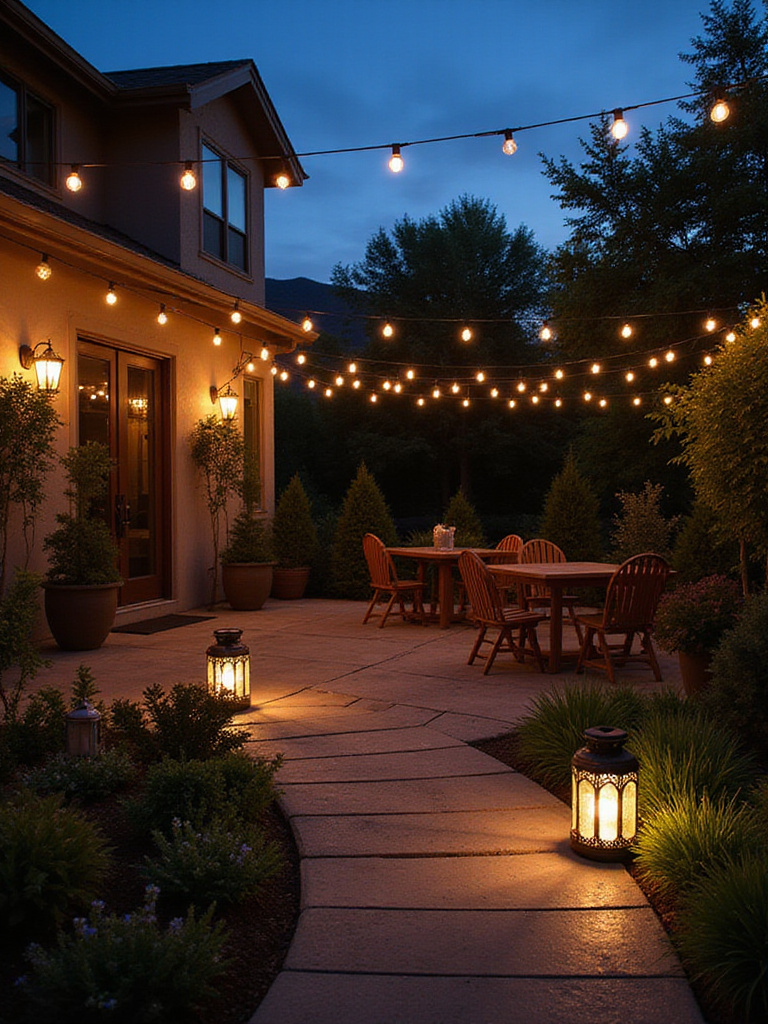
Solar works beautifully for accent lighting and areas receiving 6-8 hours of direct sunlight daily. Modern solar patio lights with quality panels and 2000mAh+ batteries can provide 8-10 hours of illumination, perfect for highlighting garden features or creating ambient pathway lighting. However, for primary task lighting or areas requiring consistent high-lumen output, electric systems remain superior. They integrate effortlessly with dimmer switches and smart controls, offering reliable performance year-round.
Consider a hybrid approach for complex outdoor spaces: use electric lights for high-traffic areas requiring dependable brightness, and supplement with solar accent lights in remote garden areas where trenching for electrical would be impractical. This strategy maximizes both functionality and cost-effectiveness while expanding your design possibilities.
With your power source decided, establishing a realistic budget ensures your vision aligns with your financial comfort zone.
6. Set a Realistic Budget for Lasting Quality
A well-defined budget for your patio lights project empowers smart decision-making while preventing the disappointment of overspending or settling for inferior quality that requires frequent replacement. Quality outdoor lighting is an investment that pays dividends through enhanced safety, increased property value, and years of reliable performance.
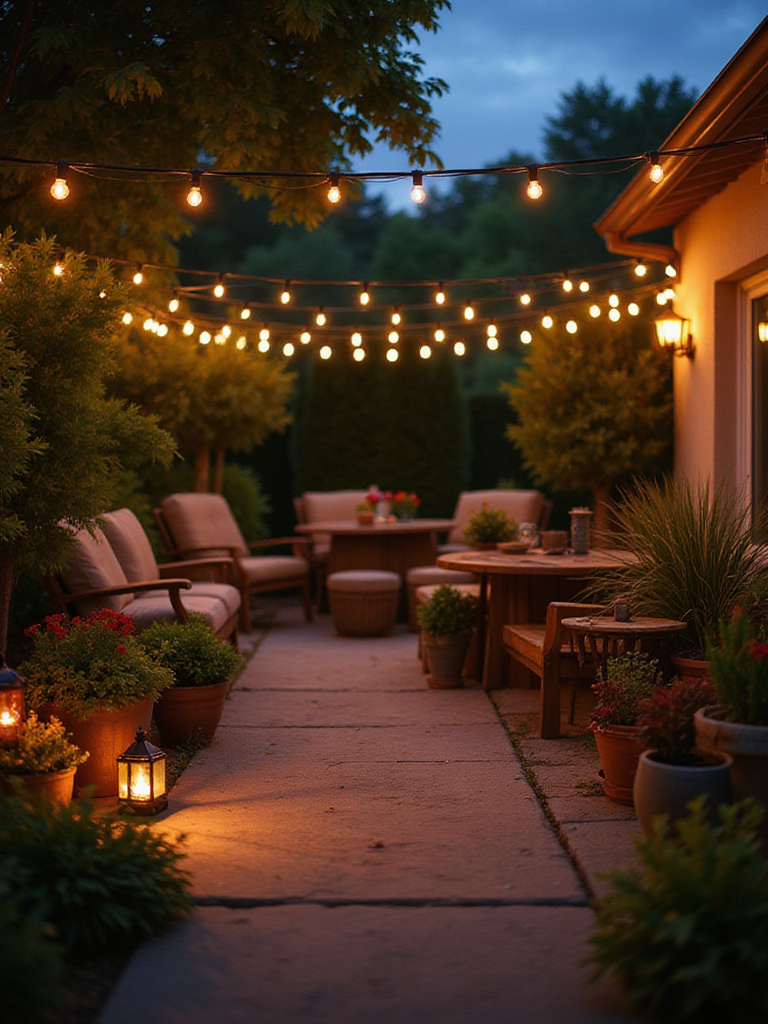
Research various lighting categories to understand price ranges: basic solar string lights might start around $30-50, while commercial-grade LED systems can range from $200-500 for comprehensive installations. Factor in accessories like transformers, weatherproof extension cords, smart controls, and potential professional installation. A good rule of thumb is adding 10-15% contingency for unexpected needs or upgrades that emerge during installation.
Remember that LED fixtures, while often more expensive initially, offer substantial long-term savings through reduced energy consumption and extended lifespans. A family working with a $200 budget achieved stunning results by purchasing commercial-grade solar LED string lights during an off-season sale, creating warm ambiance across their entire patio for under $150 with zero ongoing energy costs.
Budget established, the next crucial consideration ensures your investment withstands the elements season after season.
7. Prioritize Weather Resistance for Longevity
Selecting weather-resistant patio lights isn’t optional—it’s essential for ensuring your lighting investment performs reliably through seasons of rain, snow, humidity, and UV exposure. Quality weather-resistant fixtures can extend operational lifespan by 50-70% compared to indoor-rated alternatives while preventing dangerous electrical hazards.

Look for fixtures with appropriate IP (Ingress Protection) ratings: IP44 minimum for splash resistance, IP65 for dust-tight and water jet protection, or IP67 for temporary immersion protection. Choose materials like marine-grade stainless steel, powder-coated aluminum, or UV-stabilized polycarbonate that resist corrosion and fading. Verify that your lights carry UL Wet Listed or ETL Wet Location certifications, confirming they meet stringent safety standards for outdoor electrical use.
A coastal homeowner learned this lesson when standard string lights corroded within six months due to salt spray and humidity, requiring complete replacement at double the initial cost. Quality weather-resistant fixtures might cost 20-30% more upfront, but they prevent premature failure and maintain consistent performance for years.
Once you’ve selected durable, weather-appropriate fixtures, safe installation becomes paramount for both aesthetics and electrical safety.
8. Master Safe Installation Techniques
Proper installation of your patio lights protects against electrical hazards while ensuring your lighting display maintains its intended beauty for years. Safe installation reduces electrical incident risk by 95% while preventing premature bulb failure and wire damage that can cut operational life by 30-50%.
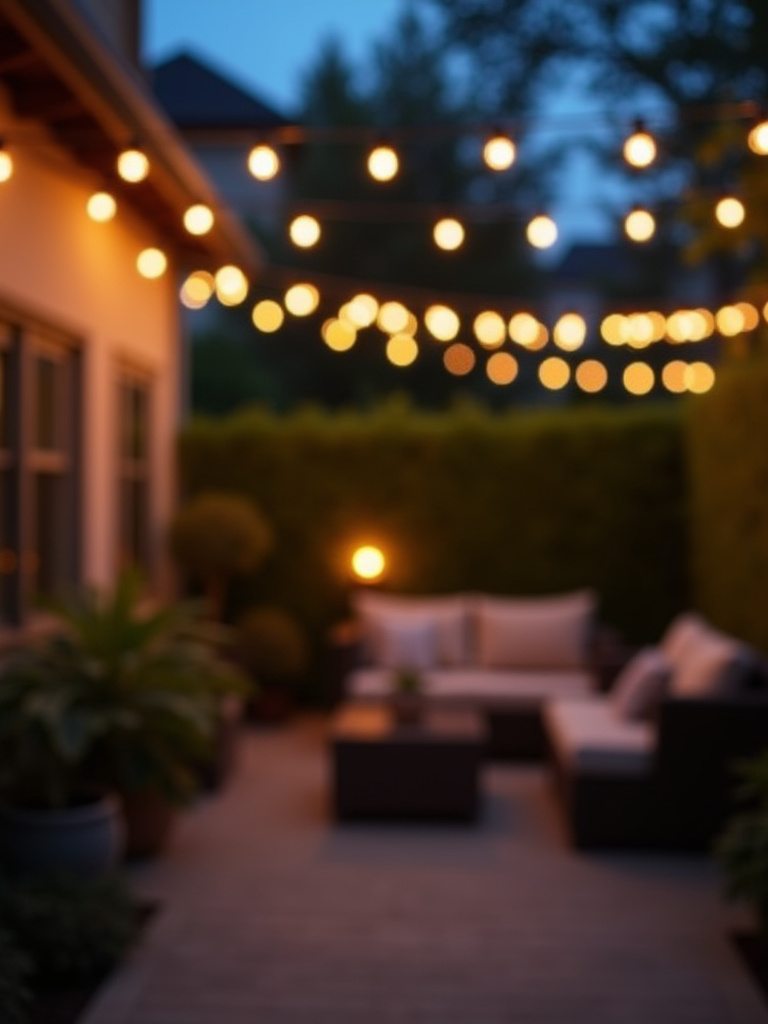
Always use outdoor-rated lights and extension cords with appropriate certifications (UL, ETL, CSA for wet locations). Calculate total wattage to avoid overloading circuits—stay below 80% of your circuit’s capacity for safety. For spans longer than 10-15 feet, install galvanized steel guide wires anchored securely to sturdy structures using eye bolts and turnbuckles. Attach lights to guide wires every 2-3 feet using zip ties or specific light clips to prevent sagging.
- Essential safety equipment: GFCI-protected outlets, outdoor-rated extension cords, weatherproof connections
- Professional installation: Required for hardwired fixtures or complex low-voltage systems
- Regular inspection: Check connections and wiring monthly for signs of wear or damage
Secure all connections with weatherproof electrical tape or silicone-filled wire nuts, keeping them elevated and away from standing water. Professional electricians emphasize that proper installation techniques prevent over 90% of potential outdoor lighting hazards.
Understanding circuit capacity becomes crucial for maintaining the safety of your electrical system.
9. Calculate Electrical Load for Safe Operation
Accurately calculating the power load of your patio lights prevents circuit overloads that can cause fires, equipment damage, and frustrating power outages during gatherings. This essential safety step ensures your electrical system operates within safe parameters while providing reliable illumination.
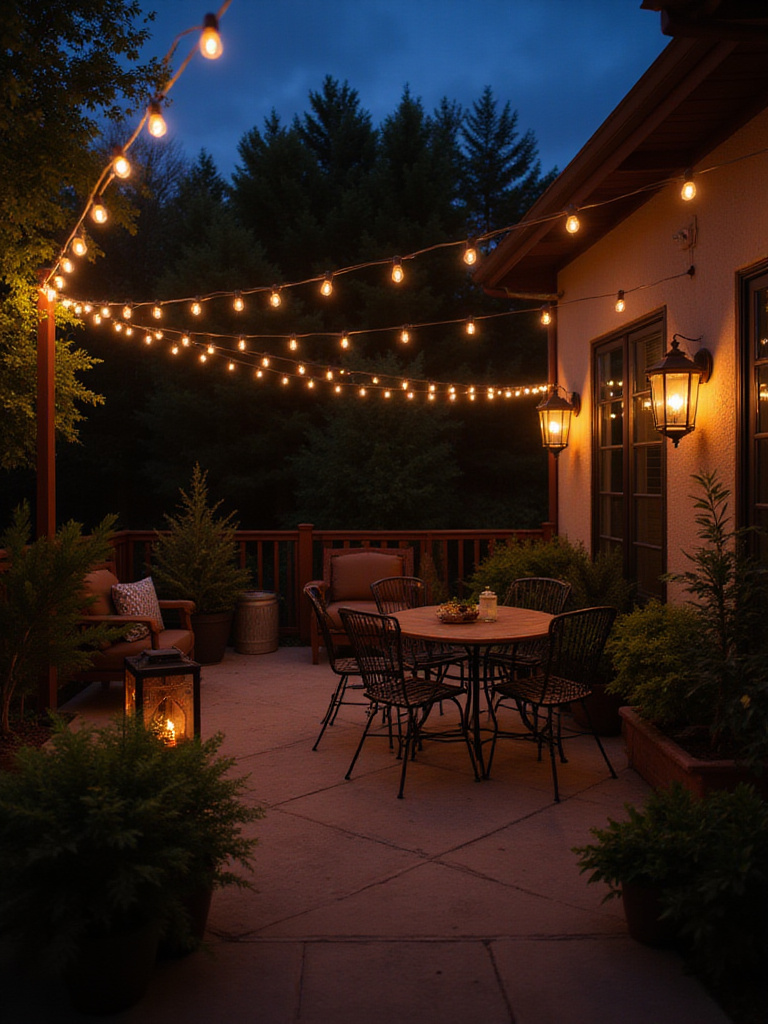
Begin by identifying your outdoor circuit’s amperage rating (typically 15A or 20A) and assume a safe working capacity of 80% (12A for 15A circuits, 16A for 20A circuits). Calculate total wattage of all planned lights by multiplying individual bulb wattage by the number of bulbs, then convert to amperage by dividing total watts by 120 volts. Ensure your calculated amperage stays below the safe capacity limit.
The Electrical Safety Foundation International reports that overloaded electrical systems cause approximately 50,000 home fires annually. A homeowner planning ten 150-watt incandescent strands (1500 watts total = 12.5 amps) discovered this exceeded their 15A circuit’s safe capacity. By switching to LED alternatives (20 watts each = 100 total watts = 0.83 amps), they created beautiful lighting while staying well within safety limits.
With electrical safety ensured, explore creative installation methods that avoid permanent modifications to your property.
10. Explore Non-Invasive Hanging Solutions
Creative, damage-free installation methods for patio lights offer unmatched flexibility while preserving your property’s integrity—essential for renters or homeowners who prefer reversible modifications. These techniques expand decorating possibilities without lease violations while eliminating potential repair costs of $50-$200 per damaged area.
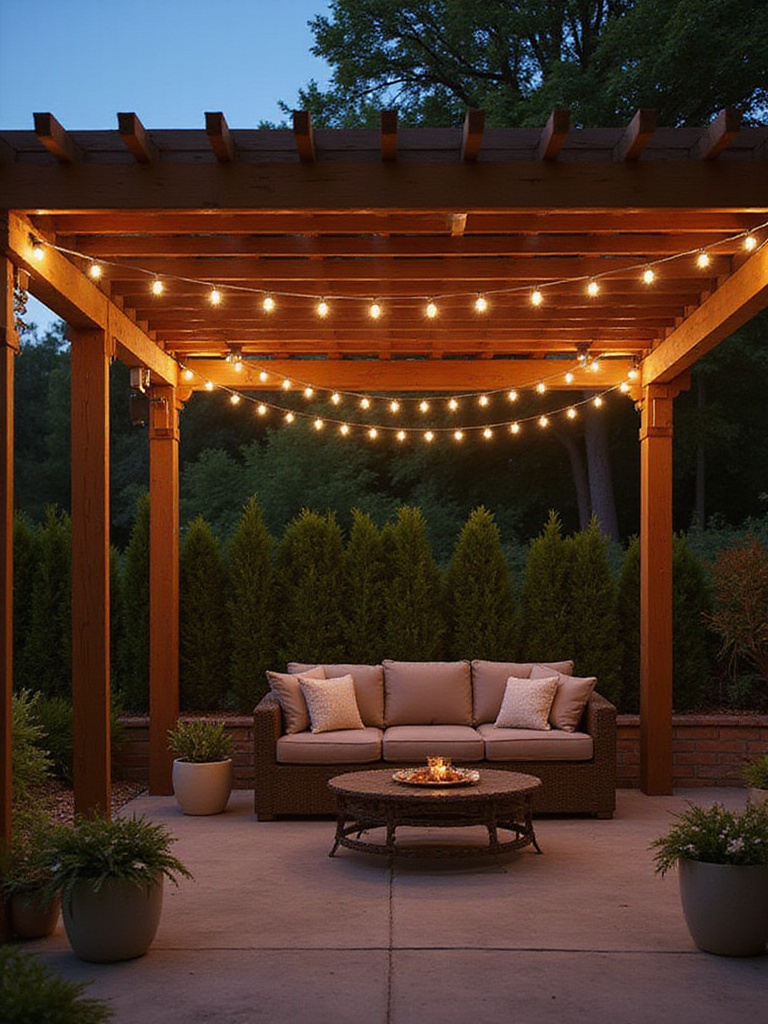
Leverage outdoor-rated adhesive hooks for smooth surfaces like vinyl siding or glass, ensuring surfaces are clean and dry for optimal adhesion. Use UV-resistant zip ties and Velcro straps to secure lights to existing structures like railings, pergolas, or tree branches. Magnetic hooks work excellently on metal surfaces like fences or patio furniture, providing strong, removable attachment points.
For open areas lacking anchor points, create freestanding supports using weighted planter pots with inserted poles (rebar or PVC), allowing you to string lights between multiple points for a canopy effect. Gutter hooks designed specifically for outdoor lights provide another non-invasive option for homes with accessible gutters.
- Adhesive solutions: Command Outdoor Light Clips for smooth surfaces
- Mechanical fasteners: UV-resistant zip ties and adjustable Velcro straps
- Weighted supports: Planter pots with inserted poles for freestanding installations
A high-rise tenant successfully created an enchanting balcony retreat using adhesive clips and solar string lights, fully complying with building regulations while achieving stunning results.
The foundation of safe, attractive installation leads naturally to the sophisticated technique of layering different light sources.
11. Layer Lighting for Sophisticated Ambiance
Layering patio lights involves strategically combining ambient, task, and accent lighting at various heights and intensities to create visual depth and functional versatility. This professional technique transforms flat, single-source lighting into dynamic, multi-dimensional outdoor environments that adapt to different activities and moods.
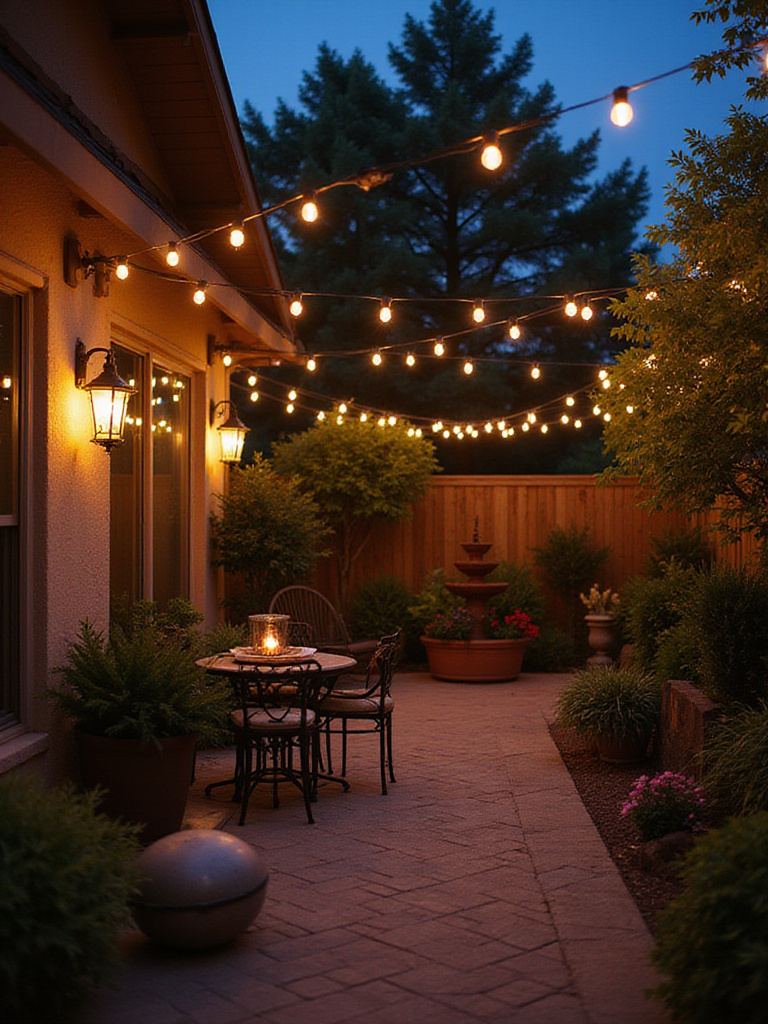
Start with ambient lighting as your foundation—string lights overhead or wall-mounted sconces providing soft, overall illumination without harsh shadows. Add task lighting for specific activities: downlights over grilling areas, adjustable floor lamps near reading chairs, or integrated lighting in outdoor kitchens. Finish with accent lighting to highlight architectural features, mature trees, or decorative elements using uplights, spotlights, or subtle path lights.
The magic happens when you can control each layer independently through dimmers or smart switches, allowing instant transitions from bright party lighting to intimate conversation settings. A well-layered system can improve functionality by 40% while reducing energy consumption by 10-20% compared to single-source lighting. Professional designers emphasize that effective layering guides the eye and creates emotional responses, transforming utilitarian spaces into experiential environments.
The ability to fine-tune your layered lighting brings us to the convenience of dimmer controls.
12. Install Dimmer Controls for Ultimate Flexibility
Dimmer switches transform your patio lights from simple on/off fixtures into sophisticated ambiance tools that adapt instantly to any occasion. This upgrade provides precise control over light intensity, extending bulb life by 2-4 times while reducing energy consumption by up to 20% through optimized brightness levels.
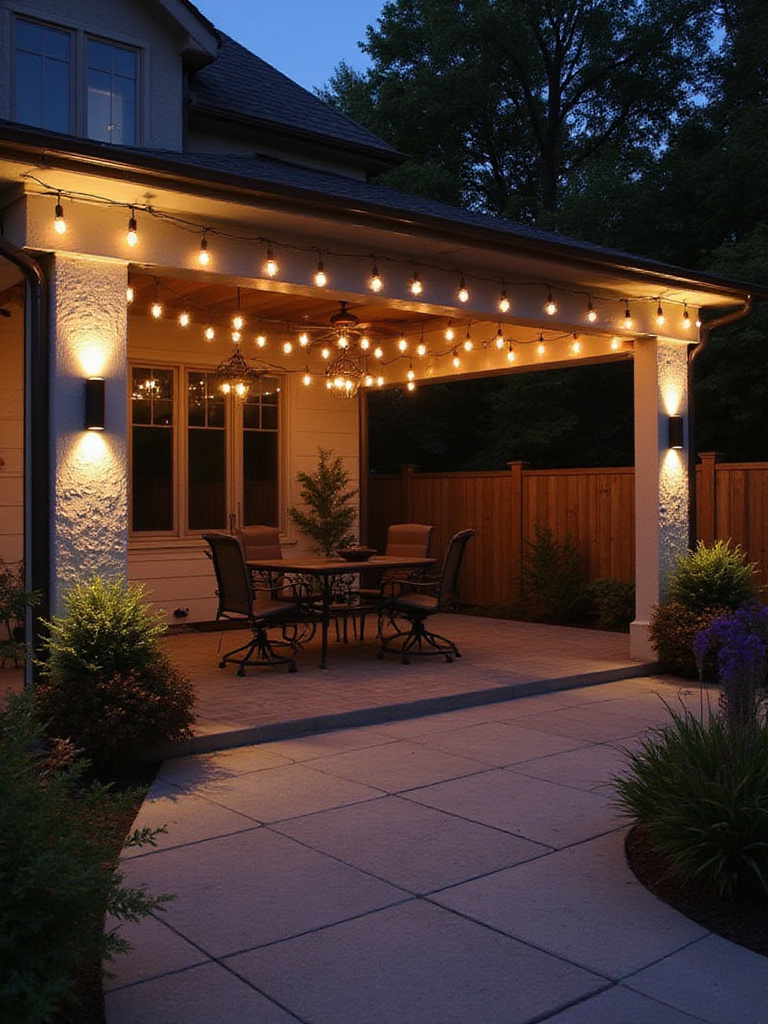
Verify that all your lights are labeled as ‘dimmable’—non-dimmable bulbs can flicker, buzz, or fail when connected to dimmers. Choose appropriate dimmer types: plug-in dimmers for string lights, in-line dimmers for low-voltage landscape lighting, or hardwired wall dimmers for permanent fixtures. Ensure the dimmer’s wattage capacity exceeds your total light load and carries appropriate outdoor ratings.
Smart dimmers offer the ultimate convenience, integrating with home automation systems for voice control, app management, and programmable schedules. A downtown restaurant uses smart dimmers on their patio lighting, automatically adjusting from 75% brightness during dinner service to 30% for late-evening ambiance, significantly enhancing customer experience and extending average visit duration.
The sophistication of dimmer controls pairs beautifully with thoughtful bulb selection that defines your space’s character.
13. Select Bulb Styles That Define Your Aesthetic
The bulb style you choose for your patio lights profoundly influences your outdoor space’s character and ambiance. Globe bulbs (G-series) create soft, diffused illumination perfect for contemporary or cozy settings, while Edison-style bulbs with visible filaments evoke vintage charm ideal for industrial, farmhouse, or classic designs.
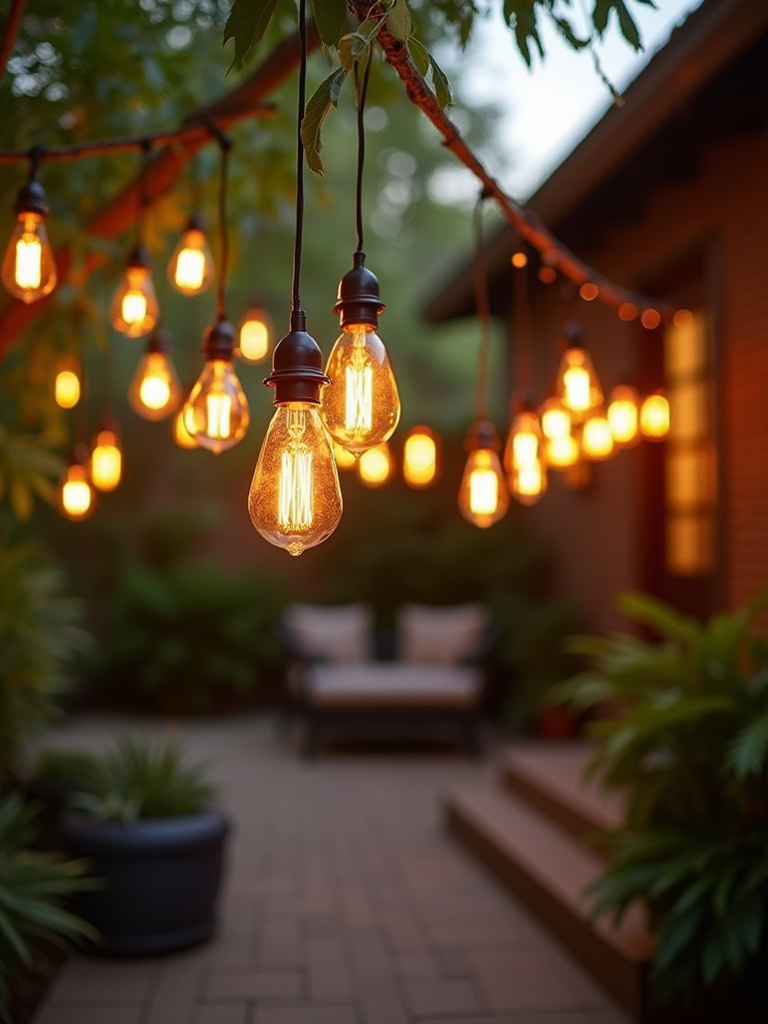
Globe bulbs eliminate harsh glare and provide even light distribution, making them excellent for dining areas or conversation spaces where visual comfort matters. Larger G40 or G50 sizes enhance the softness effect, while smaller G25s offer subtle accent lighting. Edison bulbs serve as decorative elements even when unlit, their intricate filament patterns adding visual interest to your outdoor space during daylight hours.
Consider your home’s architectural style when selecting bulb shapes: mid-century modern spaces benefit from clean-lined globe bulbs, while craftsman or farmhouse aesthetics shine with Edison-style vintage reproductions. Both styles work beautifully in warm white temperatures (2200K-2700K) that enhance their inherent character. Shatterproof LED versions provide durability for outdoor environments while maintaining authentic aesthetics.
The visual impact of well-chosen bulbs becomes even more impressive when enhanced by smart technology capabilities.
14. Embrace Smart Controls for Modern Convenience
Smart patio lights connect to your home network, enabling precise control over brightness, color, and effects directly from your smartphone or voice assistant. This technology transforms static outdoor lighting into dynamic, responsive environments that adapt instantly to any occasion while potentially reducing energy consumption by up to 60% through automated scheduling and dimming.
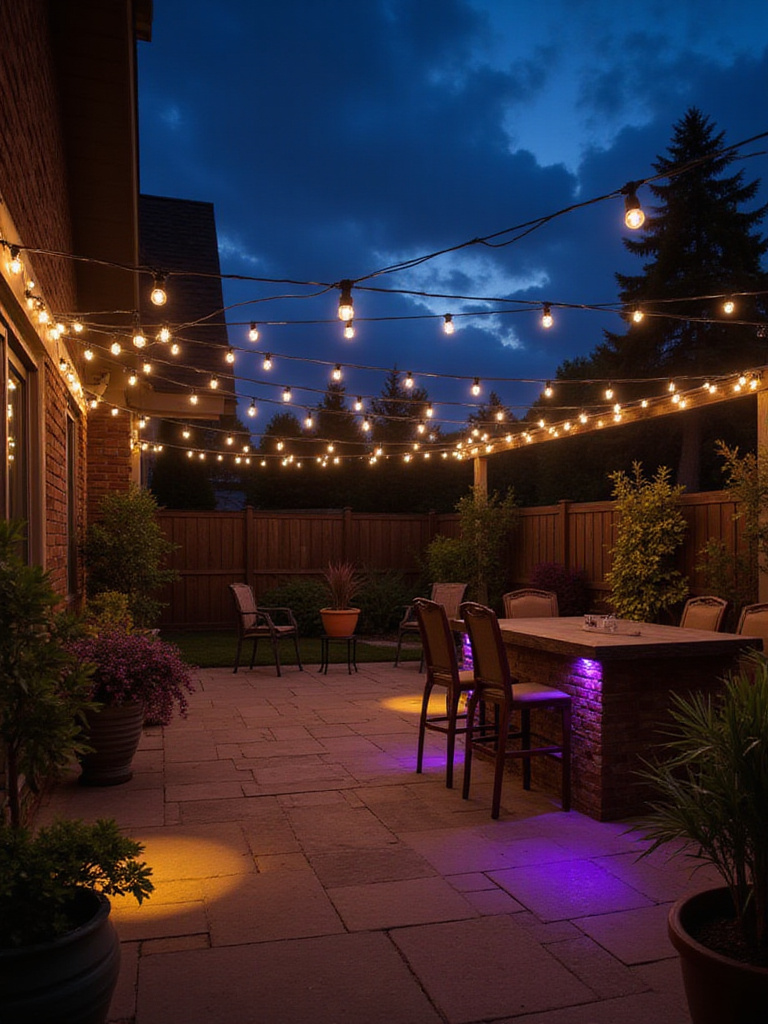
Choose lights compatible with your preferred control method: Wi-Fi direct for simplicity, Bluetooth for smaller setups, or Zigbee/Z-Wave for comprehensive smart home integration. Mount outdoor-rated smart lights (IP44 or higher) in desired locations, ensuring reliable power connections. Download the manufacturer’s app to pair lights and create custom scenes, schedules, and automations tailored to your lifestyle.
Smart lighting excels at creating themed experiences—cycling through tropical colors for luau parties, synchronizing with music for entertainment, or automatically dimming as evening progresses. A family hosting themed parties uses their smart string lights to create immersive atmospheres, with guests consistently commenting on the enhanced ambiance and engagement.
- Color customization: Millions of colors for themed events and seasonal celebrations
- Scheduling automation: Lights turn on/off automatically based on time or sunset/sunrise
- Voice integration: Control via Alexa, Google Home, or Apple HomeKit
The global smart lighting market’s projected 20.3% annual growth reflects consumers’ increasing demand for intelligent, adaptable lighting solutions.
Beyond overhead illumination, pathway lighting plays a crucial role in both safety and aesthetic guidance.
15. Install Pathway Lighting for Safety and Guidance
Pathway lights provide essential low-level illumination that guides guests safely while adding sophisticated visual appeal to your outdoor landscape. These fixtures reduce nighttime fall incidents by up to 70% while enhancing property security by eliminating dark hiding spots around your home’s perimeter.
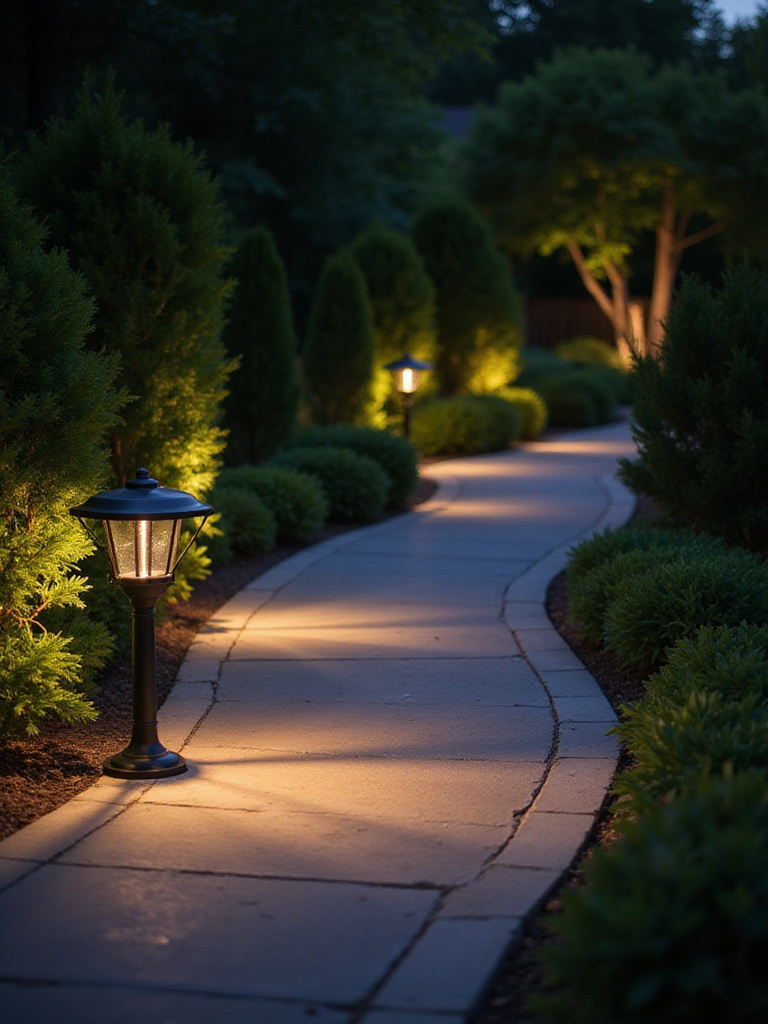
Plan your pathway lighting layout considering light spread (typically 6-8 feet apart) and identifying areas needing extra attention like steps, turns, or elevation changes. Choose between low-voltage systems (most common for DIY installation), solar options (no wiring required), or line-voltage systems (brightest output, often requiring professional installation). Dig shallow trenches for low-voltage wiring and position fixtures according to your plan.
Quality pathway lighting serves multiple purposes: safety for navigation, security through perimeter illumination, and aesthetic enhancement of landscape features. A homeowner with a winding driveway installed solar LED pathway lights every 8 feet, transforming a previously treacherous nighttime approach into a safely illuminated, welcoming entrance that guests consistently praise.
The strategic guidance provided by pathway lights complements the dramatic effects achievable through uplighting techniques.
16. Master Uplighting for Dramatic Effects
Strategic uplighting involves positioning patio lights at the base of outdoor features like mature trees, architectural elements, or sculptures, creating dramatic visual effects that transform flat landscapes into dynamic, multi-dimensional spaces. This technique can increase perceived property value by 7-12% through enhanced evening curb appeal and architectural highlighting.
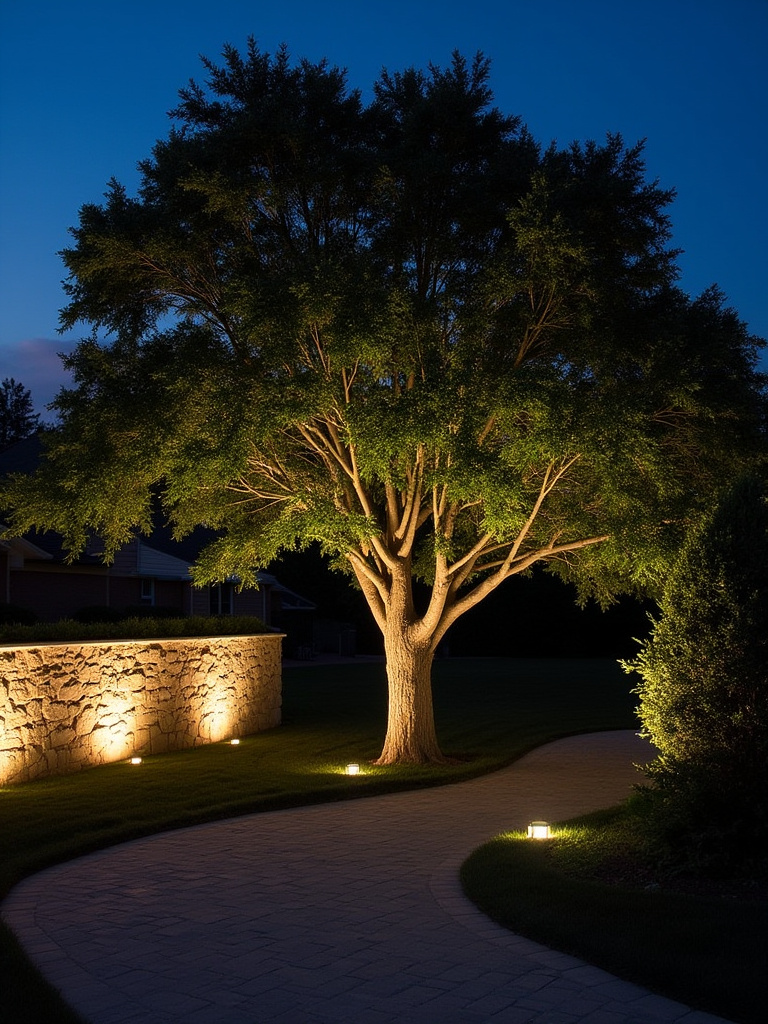
Identify key focal points during evening hours—prominent trees, unique architectural features, water elements, or sculptural pieces that would benefit from dramatic illumination. Select appropriate fixtures: bullet lights for narrow, precise beams; wash lights for broader coverage; or well lights for discreet, flush-with-ground placement. Position lights 1-3 feet from feature bases, experimenting with distance and angle to achieve desired effects.
Effective uplighting creates depth and visual interest while providing subtle ambient illumination for surrounding areas. A suburban homeowner installed LED uplights around three mature oak trees in their front yard, transforming them into stunning nighttime focal points visible from the street. The dramatic effect contributed to their home selling 10% above asking price within two weeks, with the enhanced outdoor aesthetics specifically mentioned by buyers.
The dramatic focal points created by uplighting integrate beautifully with comprehensive landscape lighting design.
17. Integrate Lighting with Landscape Design
Seamlessly integrating patio lights with your existing landscaping elevates outdoor spaces from simple gardens into captivating nighttime environments. This sophisticated approach highlights architectural plants, defines pathways, and creates focal points while extending the usability of outdoor areas well into the evening hours.
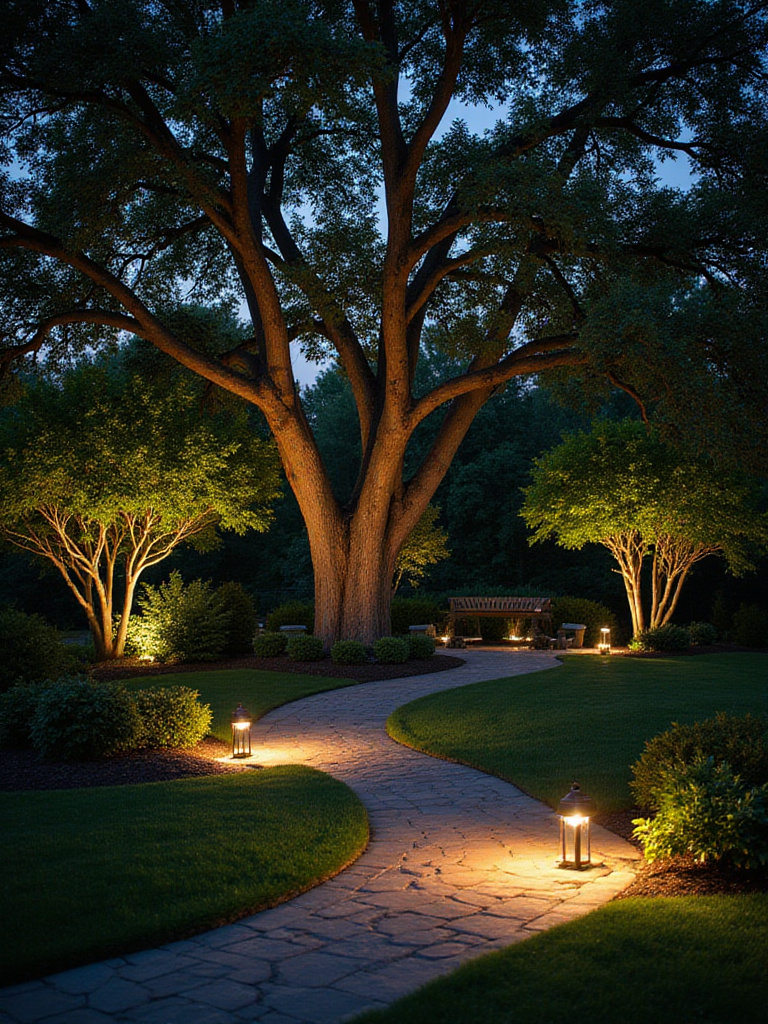
Conduct nighttime walk-throughs to identify features deserving illumination: mature trees, unique shrubs, winding paths, water features, or outdoor dining areas. Select fixture types based on purpose—uplights for trees and architectural plants, path lights for walkways, well lights for subtle ground illumination, and string lights for canopy or perimeter ambiance. Plan low-voltage wiring runs to minimize visual impact while ensuring adequate power distribution.
Professional landscape architects emphasize creating depth through light and shadow rather than uniform illumination. Focus on highlighting key features while leaving some areas in soft shadow for contrast and visual interest. A boutique hotel installed uplights at the base of heritage oak trees combined with subtle path lighting, creating an enchanting entrance that significantly boosted evening dining reservations and positive guest reviews.
- Uplighting: Highlights trees and architectural features from below
- Path lighting: Provides safe navigation while defining walkways
- Accent lighting: Creates focal points on sculptures, water features, or unique plants
Automation through timers and smart controls allows your integrated lighting to adapt seasonally as plants grow and change.
Once your beautiful lighting integration is complete, proper maintenance ensures lasting performance and safety.
18. Maintain Your Investment Through Regular Care
Routine maintenance of your patio lights ensures optimal performance, extends operational lifespan by 25-40%, and prevents safety hazards that could compromise your outdoor lighting investment. Simple, regular care maintains 95% of original illumination output while reducing replacement costs significantly over time.

Conduct monthly visual inspections for loose connections, frayed wires, damaged bulbs, or pest activity. Gently clear accumulated debris like leaves, dust, or spider webs that can impede light output and create fire hazards. Quarterly cleaning with a soft, damp microfiber cloth and mild soap solution restores bulbs and fixtures to original brilliance. Seasonally inspect all electrical connections for corrosion or wear, applying dielectric grease to outdoor connections for moisture protection.
A family in Arizona implemented bi-monthly cleaning and connection checks after experiencing frequent bulb burnouts. This simple routine extended their LED string lights’ lifespan to over four years without a single bulb replacement, far exceeding the typical 2-year average. Industry data confirms that proactive maintenance extends outdoor lighting operational life by 25-40% compared to install-and-forget approaches.
Even with diligent maintenance, occasional issues arise, making troubleshooting skills invaluable for quick resolution.
19. Troubleshoot Common Issues Effectively
Mastering basic troubleshooting for your patio lights enables quick resolution of common problems like flickering or non-working strings, potentially reducing replacement costs by 60-80% while restoring outdoor ambiance within 30-60 minutes for minor issues. Effective troubleshooting also identifies potential electrical hazards before they escalate.
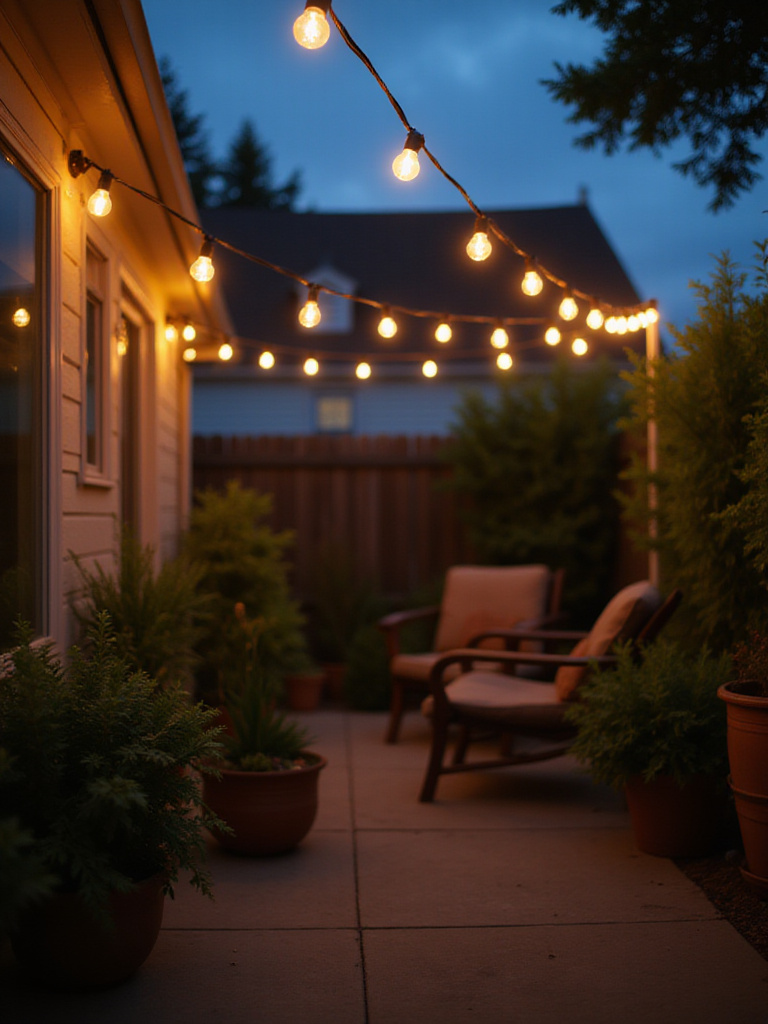
Always prioritize safety by unplugging lights before inspection. Visually examine the entire string for obvious damage like frayed wires, cracked insulation, or broken sockets. Check power sources by testing outlets with other appliances, and verify GFCI function by pressing TEST and RESET buttons. Systematically inspect each bulb for breaks or blackening, replacing suspicious bulbs with correct wattage and base type.
For persistent issues, examine socket interiors for corrosion or bent contacts, using non-conductive tools to gently adjust contacts. Apply dielectric grease to bulb bases and socket contacts to prevent moisture intrusion and improve electrical connection. A homeowner’s 50-foot cafe light string stopped working after heavy rain—following systematic troubleshooting, they discovered water in a single socket causing a GFCI trip. Twenty minutes of drying, bulb replacement, and dielectric grease application restored the entire string, avoiding $75 replacement cost.
- Safety first: Always unplug before touching any components
- Systematic approach: Check power source, then bulbs, then connections
- Preventive protection: Apply dielectric grease to prevent future moisture issues
Proper troubleshooting skills prove invaluable, but equally important is knowing how to store lights safely during off-seasons.
20. Store Lights Properly for Seasonal Longevity
Safe off-season storage extends the functional lifespan of your patio lights by up to 50% while preventing frustrating tangles and damage that necessitate premature replacement. Proper storage saves an average of $40-$100 per strand per season in replacement costs while eliminating 1-3 hours of untangling frustration during reinstallation.
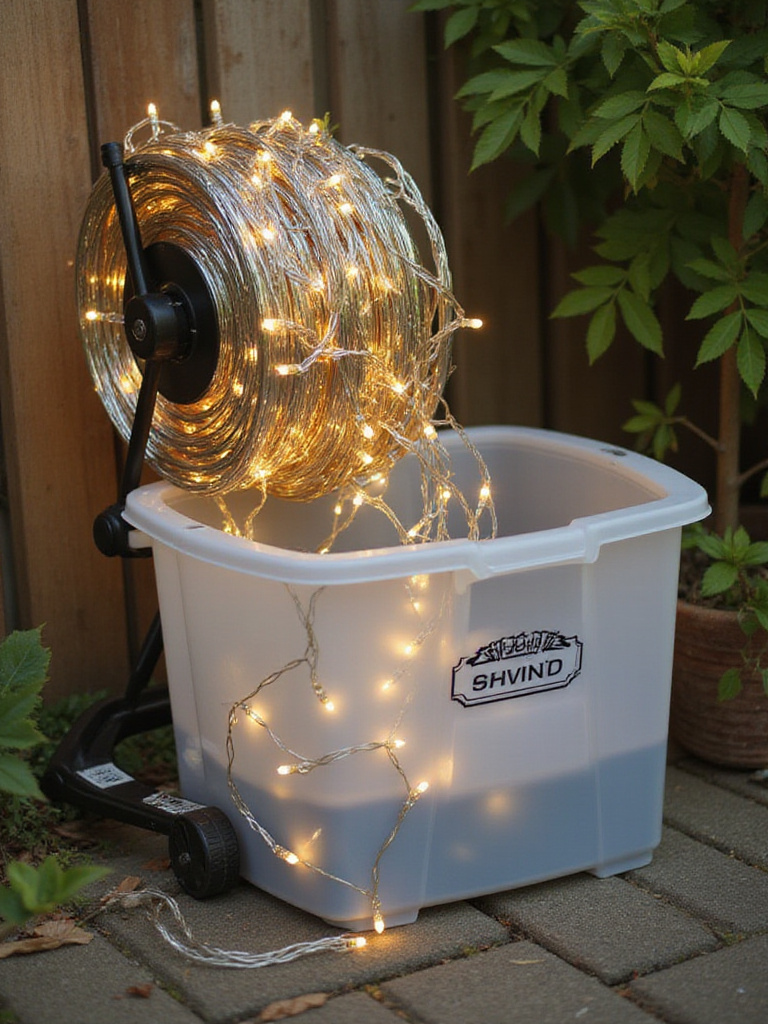
Begin storage preparation by disconnecting and thoroughly cleaning all light strands. Remove individual bulbs if designed to be removable, wiping down wires, sockets, and bulbs to remove accumulated dirt and debris. Inspect each strand for damage, addressing minor issues with electrical tape or identifying strands requiring replacement. Coil strands neatly around purpose-built cord reels, sturdy cardboard, or large buckets—avoid simply stuffing lights into containers.
Protect delicate bulbs by removing and storing them separately in padded containers like egg cartons or specialized bulb storage boxes. Use clear, airtight plastic bins to protect lights from moisture, dust, and pests, labeling each bin clearly. Store containers in cool, dry, dark locations away from extreme temperature fluctuations. A homeowner who meticulously coiled lights around plastic reels and stored them in sealed garage bins maintained fully functional, like-new lights for five seasons, saving over $300 in potential replacements.
The careful preservation of your lighting investment sets the stage for creative seasonal applications throughout the year.
21. Transform Spaces with Holiday Versatility
Repurposing your existing patio lights for holiday decor maximizes their utility while creating dynamic festive atmospheres year-round. This flexible approach can increase outdoor gathering capacity by 30% during holiday seasons while reducing dedicated holiday lighting costs by 20-50% through strategic reuse of existing installations.
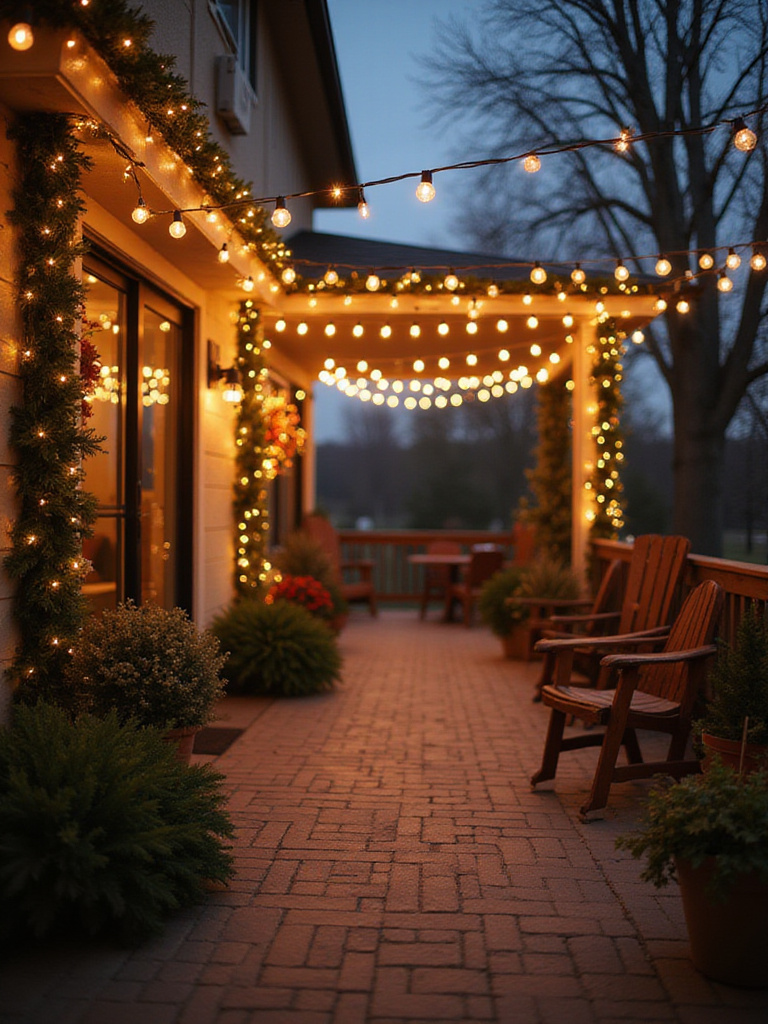
Assess your current lighting setup and plan specific holiday themes, selecting appropriate colors and additional decorative elements. Choose thematic lighting colors—warm white or amber for autumn, traditional red/green for winter holidays, pastels for spring celebrations. Smart RGBW patio lights offer ultimate versatility through dynamic color changes controlled via smartphone apps. Integrate lights seamlessly with garlands, wreaths, or decorative arches, using spotlights to highlight specific holiday features.
Smart technology enables automated holiday lighting schedules and remote control for effortless transitions between daily and festive ambiance. A Portland restaurant used their existing commercial-grade patio lights as a foundation for winter holiday themes, adding colored bulbs and evergreen garlands. This simple enhancement increased December outdoor dining reservations by 35%, directly attributed to the inviting festive atmosphere.
- Color coordination: Match lighting to specific holiday themes and traditions
- Smart automation: Program custom holiday sequences and schedules
- Layered integration: Combine existing lights with seasonal decorative elements
The National Retail Federation reports that 76% of consumers plan holiday decorating, with outdoor displays representing significant spending that strategic lighting reuse can minimize.
Conclusion
Your journey through these 21 brilliant patio light ideas has revealed the transformative power of thoughtful outdoor illumination. From the foundational steps of defining purpose and measuring spaces to the sophisticated techniques of layering, uplighting, and smart controls, each strategy contributes to creating an outdoor environment that truly extends your living space into the evening hours.
The beauty of well-planned patio lights lies not just in their immediate visual impact, but in their ability to enhance safety, increase property value, and create countless opportunities for outdoor enjoyment. Whether you’ve been inspired by the vintage charm of Edison bulbs, the modern convenience of smart controls, or the dramatic effects of strategic uplighting, remember that the best lighting schemes evolve over time, growing more refined as you discover what truly serves your lifestyle.
As you embark on your own lighting transformation, embrace the process of experimentation and refinement. Start with a solid foundation of purpose-driven planning, invest in quality weather-resistant fixtures, and don’t hesitate to layer different lighting types for maximum versatility. Your outdoor space holds incredible potential—with these insights and techniques, you’re well-equipped to unlock its full evening magic and create the illuminated sanctuary you’ve always envisioned.
